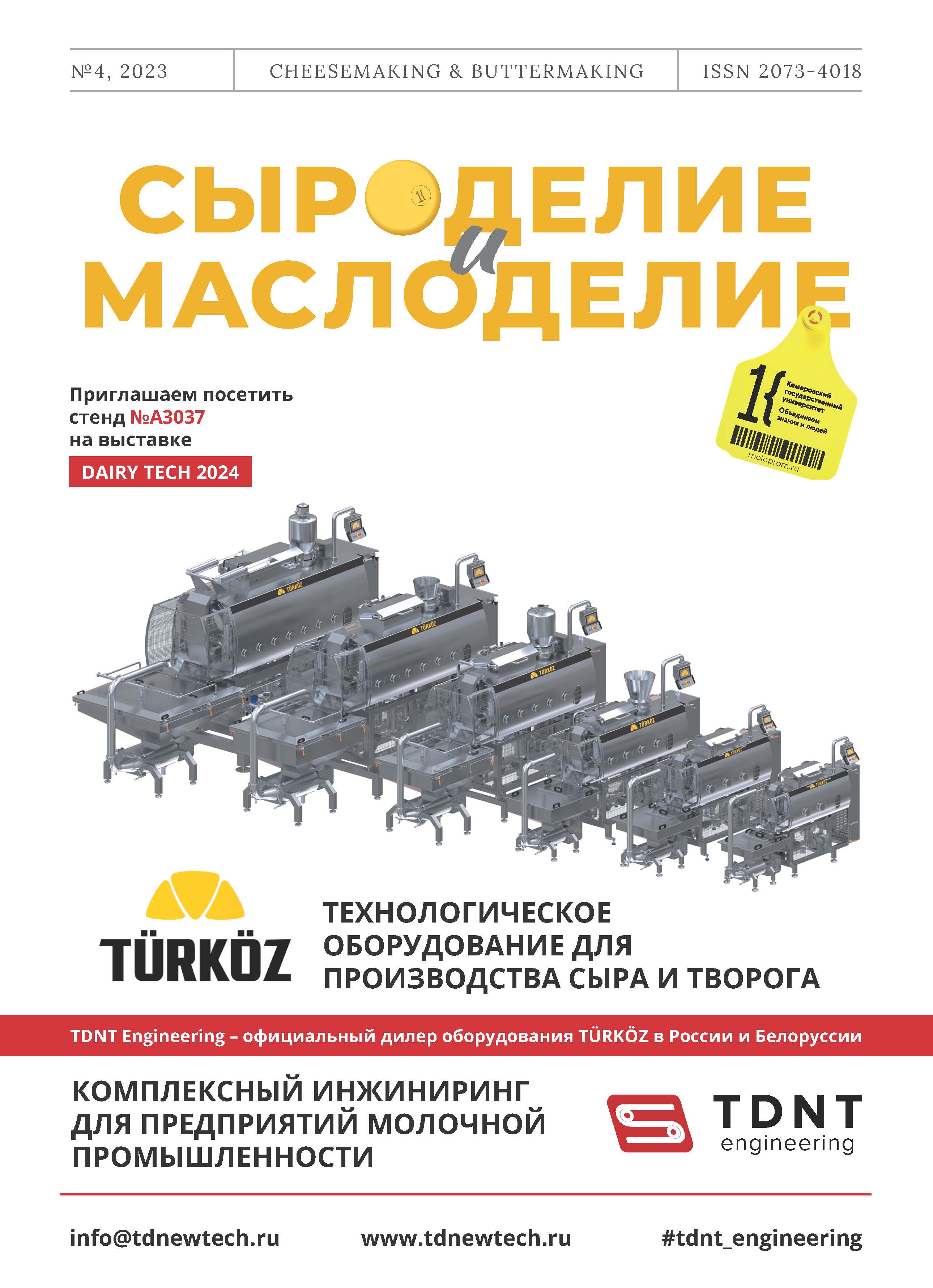Uglich, Russian Federation
Uglich, Russian Federation
Uglich, Russian Federation
Uglich, Russian Federation
The article describes the changes in the physicochemical and rheological parameters of various natural cheeses after their thermomechanical processing. The experimental heat-treated cheeses consisted of natural cheese, citrate-phosphate emulsifying salt, and water. The test parameters involved mass fraction of moisture and fat, active acidity, elastic modulus, dynamic viscosity, and tg δ, i.e., the loss vs. elastic modulus ratio. All these indicators affected the functional properties of the resulting pizza cheeses. Citrate-phosphate emulsifying salts increased the buffer capacity and stabilized the active acidity of the heat-treated cheeses relative to the natural cheese samples, blue cheeses and cheddared cheese masses being the only exceptions. Emulsifying salts and water reduced the fat content. The thermal treatment also lowered such indicators as elastic modulus, dynamic viscosity, and tg δ, which affected the consistency of the final product. After the thermomechanical processing, the natural cheeses became less dense but more elastic, plastic, and loose. Their physicochemical and rheological characteristics changed, which means that the thermal treatment gave the resulting heat-treated pizza cheeses some functionally useful properties.
heat-treated cheese, cheese, physicochemical properties, rheological properties, thermization, quality
1. GOST R 59212-2020. Syry dlya piccy termizirovannye. Tehnicheskie usloviya = Cheeses for pizza termized. Specifications: nacional'nyy standart Rossiyskoy Federacii: izdanie oficial'noe: utverzhden i vveden v deystvie Prikazom Federal'nogo agentstva po tehnicheskomu regulirovaniyu i metrologii ot 25.11.2020 g. № 1173-st: data vvedeniya 2021-01-01. - Moskva: Standartinform, 2020. - 12 s.
2. Sviridenko, G. M. Research on the possibility of extending the shelf life of cheese raw material and heat-treated cheese by their freezing for further use in HoReCa / G. M. Sviridenko [et al.] // Food systems. 2020. №3 (4). R. 39-44. DOI: https://doi.org/10.21323/2618-9771-2020-3-4-39-44.
3. Rybalova, T. I. Pravil'nyy syr - glavnyy sekret uspeha piccy / T. I. Rybalova // Syrodelie i maslodelie. 2020. №2. S.8-12.
4. Lee, B. O. Ultrastructural study on processed cheese. Effect of different parameters / B. O. Lee, G. Kilbertus, C. Alais. // Milchwissenschaft. 1981. № 36. R. 343-348.
5. Shan, J. Characterization of the processing conditions upon textural profile analysis (tpa) parameters of processed cheese using near-infrared hyperspectral imaging. / J. Shan [et al.] // Analytical Letters. 2020. № 53 (8). R. 1190-1203. DOI: https://doi.org/10.1080/00032719.2019.1700421
6. Tamim, A. Y. Plavlenye syry i syrnye produkty / A. Y. Tamim [Perevod s angliyskogo]. - SPb: Professiya, 2013. - 376 s.
7. Talbot-Walsh, G. A review on technological parameters and recent advances in the fortification of processed cheese / G. Talbot-Walsh, D. Kannar, C. Selomulya // Trends in Food Science & Technology. 2018. № 81. R. 193-202. DOI: https://doi.org/10.1007/978-1-4899-7681-9_17
8. Belsito, P. C. Manufacture of Requeijão cremoso processed cheese with galactooligosaccharide / P. C. Belsito [et al.] // Carbohydrate Polymers. 2017. № 174. R. 869-875. DOI: https://doi.org/10.1016/j.carbpol.2017.07.021
9. Kalab, M. Textural properties and microstructure of process cheese food rework / M. Kalab, J. Yun, S. H. Yiu // Food Structure. 1987. № 6 (2). Article 10.
10. Lenze, S. Effect of the compositional factors and processing conditions on the creaming reaction during process cheese manufacturing / S. Lenze [et al.] // Food and Bioprocess Technology. 2019. № 12. R. 575-586. DOI: https://doi.org/10.1007/s11947-019-2234-6
11. Garimella Purna S. K. Effect of formulation and manufacturing parameters on process cheese food functionality. 1. Trisodium citrate / S. K. Garimella Purna, A. Pollard, L. E. Metzger // Journal of Dairy Science. 2006. № 89. R. 2386-2396.
12. Rukke, E. O. Rheology, texture and meltability of different types of cheese / E. O. Rukke, R. K. Abrahamsen, R. B. Schüller. // Annual transactions of the nordic rheology society. 2018. № 26. R. 211-218.
13. Banville, V. Impact of thermo-mechanical treatments on composition, solids loss, microstructure, and rheological properties of pasta filata-type cheese / V. Banville [et al.] // International Dairy Journal. 2016. № 61. R. 155-165. DOI: https://doi.org/10.1016/j.idairyj.2016.05.004
14. Bähler, B. Evaluation of oscillatory and shear strain behaviour for thermo-rheological plasticisation of non-ripened cheese curd: Effect of water, protein, and fat. / B. Bähler, R. Back, J. Hinrichs. // International Dairy Journal. 2015. № 46. R. 63-70. DOI: https://doi.org/10.1016/j.idairyj.2015.01.002
15. Sviridenko, G. M. Possibility of using natural cheeses for pizza production / G. M. Sviridenko, A. N. Shishkina, V. V. Kalabushkin // Food systems. 2023. № 6 (3). R. 416-423. DOI: https://doi.org/10.21323/2618-9771-2023-6-3-416-423






